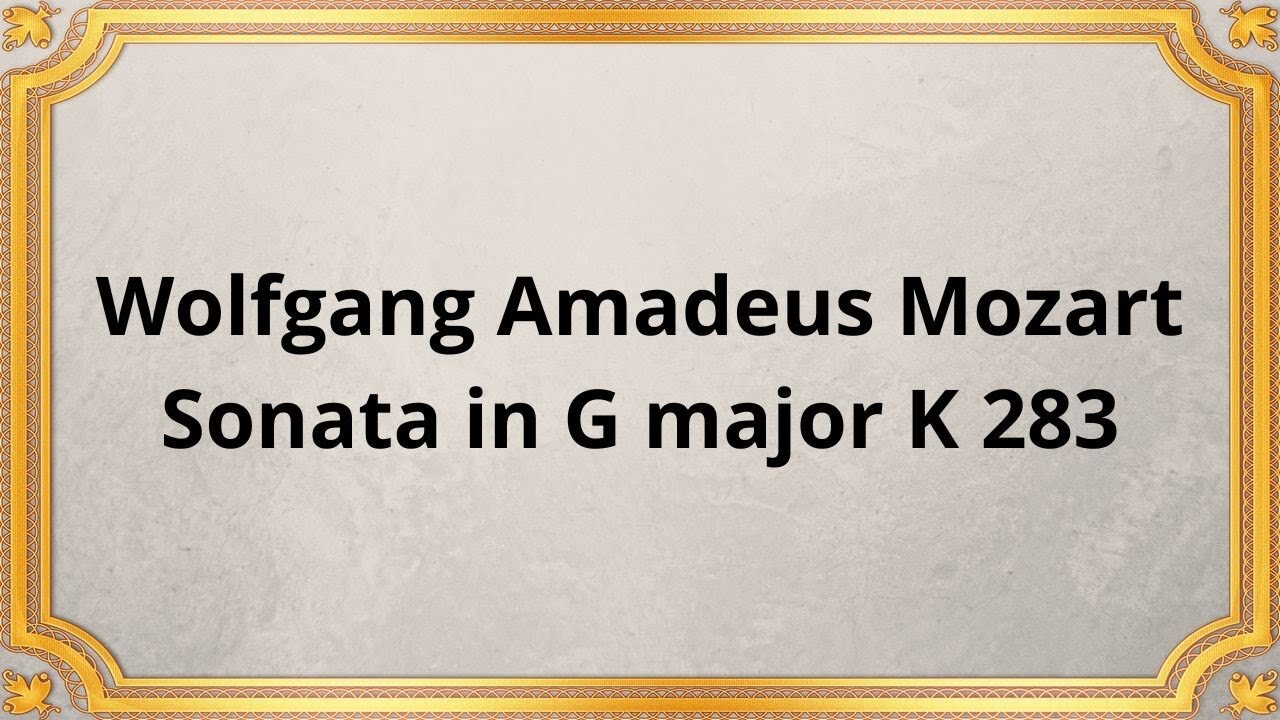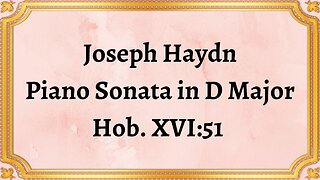Premium Only Content

Wolfgang Amadeus Mozart Sonata in G major K 283
#Mozart #Sonata #ClassicalMusic #MusicalComposition #Gmajor #K283 #Piano #Composer #BaroqueMusic #MusicHistory
Publication date 1938
Kathleen Long (piano)
Wolfgang Amadeus Mozart, one of the most influential composers in music history, left behind a vast repertoire of masterpieces. Among his remarkable compositions, the Sonata in G Major K. 283 stands as a shining example of his genius.
The Sonata genre has been a staple of classical music since the Baroque period, consisting of a single instrument or a solo instrument accompanied by a keyboard instrument. Mozart's Sonata in G Major K. 283 perfectly exemplifies this genre, showcasing his exceptional ability to create captivating and harmonically rich compositions.
Mozart composed the Sonata in G Major K. 283 in 1774 when he was just 18 years old. The piece consists of three movements, adhering to the classical sonata structure:
1. Allegro: This opening movement is lively and spirited, featuring a delightful and playful melody. It showcases Mozart's ability to create catchy and memorable themes, while also incorporating moments of depth and complexity.
2. Andante: The second movement is a lyrical and introspective piece, contrasting the energetic nature of the first movement. It showcases Mozart's gift for crafting beautiful and expressive melodies, evoking a sense of tranquility and introspection.
3. Presto: The final movement is a fast-paced and virtuosic display of technical skill. It exudes a sense of joy and excitement, with intricate passages and rapid fingerwork, demonstrating Mozart's prodigious talent as a composer and pianist.
Mozart's Sonata in G Major K. 283 is filled with enchanting melodies that are both elegant and memorable. The composer's gift for crafting captivating and emotionally resonant themes is evident throughout the piece, drawing the listener into a world of beauty and musical expression.
Mozart's harmonic choices in K. 283 are both innovative and sophisticated. His use of unexpected chord progressions and harmonic shifts adds depth and complexity to the composition, elevating it beyond mere technical brilliance.
The sonata showcases Mozart's ability to utilize dynamic contrasts to create impactful musical moments. From delicate and tender passages to bold and powerful sections, the range of dynamics adds a compelling dimension to the composition.
Mozart's Sonata in G Major K. 283 demonstrates his mastery of form and structure. The seamless transitions between movements, balanced thematic development, and overall coherence contribute to the sonata's timeless appeal.
Mozart's Sonata in G Major K. 283 holds great significance within the realm of classical music. It showcases Mozart's prodigious talent as a composer, even at a young age, and serves as a testament to his enduring legacy. The piece exemplifies the elegance, beauty, and technical brilliance that define Mozart's music. It has been admired by musicians and audiences alike for centuries, earning its place as one of the notable piano sonatas in the classical repertoire.
Conclusion:
Wolfgang Amadeus Mozart's Sonata in G Major K. 283 is a testament to the composer's prodigious talent and his contributions to the world of classical music. With its melodic beauty, harmonic sophistication, and expressive dynamics, the sonata continues to captivate audiences and serves as a reminder of Mozart's enduring legacy. It stands as a shining gem within the classical music canon, cherished for its timeless elegance and musical brilliance.
You have the opportunity to support the channel:
https://destream.net/live/RadSiarAl/donate
https://www.buymeacoffee.com/6355radsiaral
-
 6:07
6:07
Classical music_Music Inspiration
10 days agoJoseph Haydn Piano Sonata in D Major, Hob. XVI:51
401 -
 3:12:37
3:12:37
Danny Polishchuk
12 hours agoTariffs and Trade Wars + Nick Rochefort | Low Value Mail #136
54.5K3 -
 2:04:40
2:04:40
I_Came_With_Fire_Podcast
14 hours agoCartels vs The United States, Fentanyls 2 Front WAR, and FTOs
31.2K -
 4:54
4:54
CryptoWrld
15 hours ago $1.94 earnedCrypto Startup Launches Tokenized US Treasury Bonds
31.1K4 -
 2:29:15
2:29:15
We Like Shooting
21 hours ago $1.25 earnedWe Like Shooting 596 (Gun Podcast)
22.5K -
 54:43
54:43
Kimberly Guilfoyle
14 hours agoThe Trump Effect: Mexico Folds, Live with Dinesh D’Souza & Chuck DeVore | Ep.193
106K34 -
 1:20:47
1:20:47
Redacted News
13 hours agoMexico CAVES to Trump over tariffs, USAID Shutdown, & Zelensky loses $200 billion | Redacted Live
188K467 -
 1:02:29
1:02:29
The StoneZONE with Roger Stone
9 hours agoIs GOP Sen. Bill Cassidy Playing Politics with RFK Jr. Vote as U.S. Faces Public Health Crisis?
37.5K5 -
 1:10:30
1:10:30
BIG NEM
12 hours ago📢 THE JOLLOF-OFF: The Battle for West African Cuisine! 🇳🇬🔥🇬🇭
31.2K4 -
 54:58
54:58
LFA TV
1 day agoThe Trade War Begins | TRUMPET DAILY 2.3.25 7pm
57.2K27